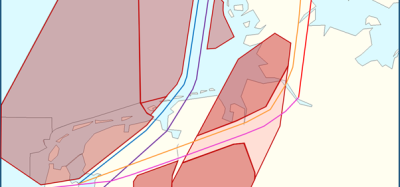Airport CDM and the ground handling industry
- Like
- Digg
- Del
- Tumblr
- VKontakte
- Buffer
- Love This
- Odnoklassniki
- Meneame
- Blogger
- Amazon
- Yahoo Mail
- Gmail
- AOL
- Newsvine
- HackerNews
- Evernote
- MySpace
- Mail.ru
- Viadeo
- Line
- Comments
- Yummly
- SMS
- Viber
- Telegram
- Subscribe
- Skype
- Facebook Messenger
- Kakao
- LiveJournal
- Yammer
- Edgar
- Fintel
- Mix
- Instapaper
- Copy Link
Posted: 6 February 2007 | Elisabeth Lagios, Airport CDM Project Manager, EUROCONTROL | No comments yet
It is a fact that airports currently face the challenge of constantly increasing air traffic demand. Very few new airports are planned or under construction, and a saturated infrastructure will, in turn, make the job of maintaining maximum operational efficiency more and more complex.
It is a fact that airports currently face the challenge of constantly increasing air traffic demand. Very few new airports are planned or under construction, and a saturated infrastructure will, in turn, make the job of maintaining maximum operational efficiency more and more complex.
With the division of liability for Ground Handling functions varying at European airports, and the ever increasing pressure to deliver and maintain service level agreements with Airlines, Airport Collaborative Decision Making (CDM) will aid ground handling companies to maximise the use of resources with improved planning opportunities.
Airport CDM helps airport partners to meet the challenge
No individual partner at an airport has the complete operational picture; even though airports are awash with data, this is not commonly shared between all partners. With either insufficient or unreliable information, ground handlers like all other airports partners are unable to operate at maximum operational efficiency, which, in turn, leads to reductions in punctuality.
The objective of Airport CDM is to bring all main airport partners (ATC, Airport Authorities, Airlines, CFMU and Ground Handlers) together in a coherent, harmonised and transparent way to share operational data (Figure 1). The sharing of information is essential for achieving common, operational situational awareness and to enhance the current decision making processes. This will result in maximised use of the available airport infrastructure, improved resource management and, ultimately, enhanced operational efficiency.
Over the last few years, EUROCONTROL has both developed and trialled a number of Airport CDM elements (see Figure 2) and is proactively encouraging European airports to implement Airport CDM locally. It must be stated from the outset that Airport CDM is not just a system, hardware or software, meeting or telephone call. It involves a culture change, the handling of sensitive data, procedural changes and building confidence and understanding of each partner’s operational processes and requirements.
Airport CDM elements
The specific functionalities of the airport CDM elements have been designed to improve the predictability of operations under various circumstances.
Information Sharing is the foundation of Airport CDM at an airport and facilitates the implementation of all other CDM elements. Information flows between all partners will be improved by combining data from different sources and predominately coupling airline and airport data with ATC flight plan data.
With an enhanced information platform in place, significant improvements can be achieved by implementing the Milestone Approach. This CDM element, by defining critical events in the progress of a flight, ensures that arrivals – turn-round – departures become one continuous process. Sixteen significant milestones have been identified and illustrated below (see Figure 3):
Variable Taxi time Calculations aim to improve adherence to scheduling with the introduction of realistic taxi times. These times will be used for the calculation of take off times required by the CFMU and will take into consideration the runway in use, stand location, aircraft type etc. and eventually replace the current default taxi times used by the CFMU. With more accurate times used, improved punctuality and ATC slot adherence is expected. In the same way, variable taxi-in times will assist for the calculation of more accurate estimations of arrival times on the stand or at the gate, as required by handling agents for their operations.
Today, airports are still seen as ‘black holes’ with very little interaction with the Air Traffic Flow and Capacity Network (ATFCM). Airport CDM is seen as the driver and mechanism to dynamically enhance the integration of airports to the network capacity management process by ensuring that available and relevant airport data from strategic to tactical is input into the ATFCM network. The Collaborative Management of Flight Updates is the catalyst for this process through enhanced data exchange between airports and the CFMU. Successful message exchange trials have already commenced between airports and the CFMU. These airports have been providing the CFMU with up-to-date estimated take off times from three hours prior to push back until the moment of take off. In turn, the CFMU can provide airports with estimated landing times for all flights destined for their airport. These estimates are based on radar data and are proving very accurate and beneficial to airport partners over the accuracy of traditional movement messages when these are available.
The Collaborative Predeparture Sequence is probably one of the most beneficial CDM elements to ground handling companies. For many years, push back from stand has been on the principle of ‘first come first served,’ which we all know is not always the optimal way of working. Airport CDM does not claim to reduce the number of unexpected delays that can occur during the turn round of an aircraft. Aircraft will still develop technical problems, passengers will be lost in the restaurants and shops, and other unexpected delays will still transpire. Ground Handling companies, being at the sharp-end of the ground operation, are best placed to disseminate the progress of an aircraft turn round amongst all partners and the objective of this CDM element is for ATC to receive confirmation of accurate Target off Block Times at an agreed time before departure, normally around twenty minutes. ATC will provide, in return, anticipated Target Start Approval Times after factors like ATC slot times, congestion and variable taxi times have been calculated. Additionally, this element will allow airlines and ground handlers to communicate preferences and priorities to ATC. This element uses information from other CDM elements described above and improves operational situational awareness to all parties. Stand Management will be improved with reduced last minute stand changes for arriving aircraft and, most importantly, more efficient use of existing equipment and staff.
Airports will continue to suffer from time to time from disruption including adverse weather conditions, industrial action and security situations, and the recovery time to normal operations is always long. By implementing the CDM in Adverse Conditions locally at an airport a collaborative capacity management process is put in place. This element ensures the dissemination of relevant information to all partners in anticipation of disruptions or to facilitate expeditious recovery from adverse situations. No two airports are the same but all will require specific procedures to be put in place and activation of specific cells, like deicing for example.
Airport CDM is a cost effective solution
Airport CDM is a low cost and efficient solution to many issues facing airports today, but for its success all partners need to work together. Airport partners still frequently work in isolation with limited understanding of each other’s operational processes. Airport CDM is not ‘Rocket Science’ and does not intend to increase anyone’s workload, but cultural and procedural changes are needed for smooth and rapid implementation.
A good number of airports are in the process of implementing airport CDM. For some time Brussels, Munich and Zurich have applied CDM as an official procedure at their airport and are already experiencing the benefits of reduced taxiing, less fuel burn, better utilisation of resources by handing companies and airport operators, as well as better runway utilisation.
A recent Cost Benefit Analysis (CBA) which considered the CDM implementation results at four major European airports has shown very positive results. Airport CDM has demonstrated to be a cost effective method of improving efficiency and predictability in airport operations. The business case for Airport CDM is extremely positive, showing a Benefit to Cost Ratio of 9 to 1.
This recent CBA study has confirmed that Airport CDM is beneficial for all partners. The investment required from any single airport partner is modest and in many cases, existing equipment, facilities and services can be utilised with only limited modifications. On the benefit side, airlines are on top, followed by the airport operator and the ground handling companies.
It is important to highlight that not every benefit can be expressed in monetary terms. The analysis shows that there are many qualitative benefits which contribute to the general feeling of Airport CDM being desirable. A few examples of this are more predictable work load (ATC), improved customer satisfaction (Ground Handlers), improved overall image (Airport) and higher quality of service (ATC).
Ground handling as an Integral part of airport CDM
Ground Handling Companies are an integral part of Airport CDM, with significant benefits achievable. There is an urgent need for improved transparency and accuracy at airports or we will continue to base decisions on insufficient or inaccurate information. Only with improved predictability will we be able to enhance operational planning and maximise resource and infrastructure usage.
The EUROCONTROL Airport CDM Team will continue to actively support local airport partners in successfully implementing Airport CDM. This will be achieved by continued development, harmonisation and dissemination of new methods and best practice to meet requirements and expectations of Airport partners. EUROCONTROL have also produced a user friendly Airport CDM Implementation Manual with step by step guidance material for airport partners to implement CDM locally. Apart from in depth material on the above mentioned CDM elements, the Manual includes chapters on setting up the project, strategies, marketing, key performance indicators, procedures, risks & mitigation, frequently asked questions and how to measure achievements.
Additional information can be found on the EUROCONTROL dedicated Airport CDM website www.eurocontrol.int/airports
Issue
Related topics
Airport Collaborative Decision Making (A-CDM), Ground handling

















